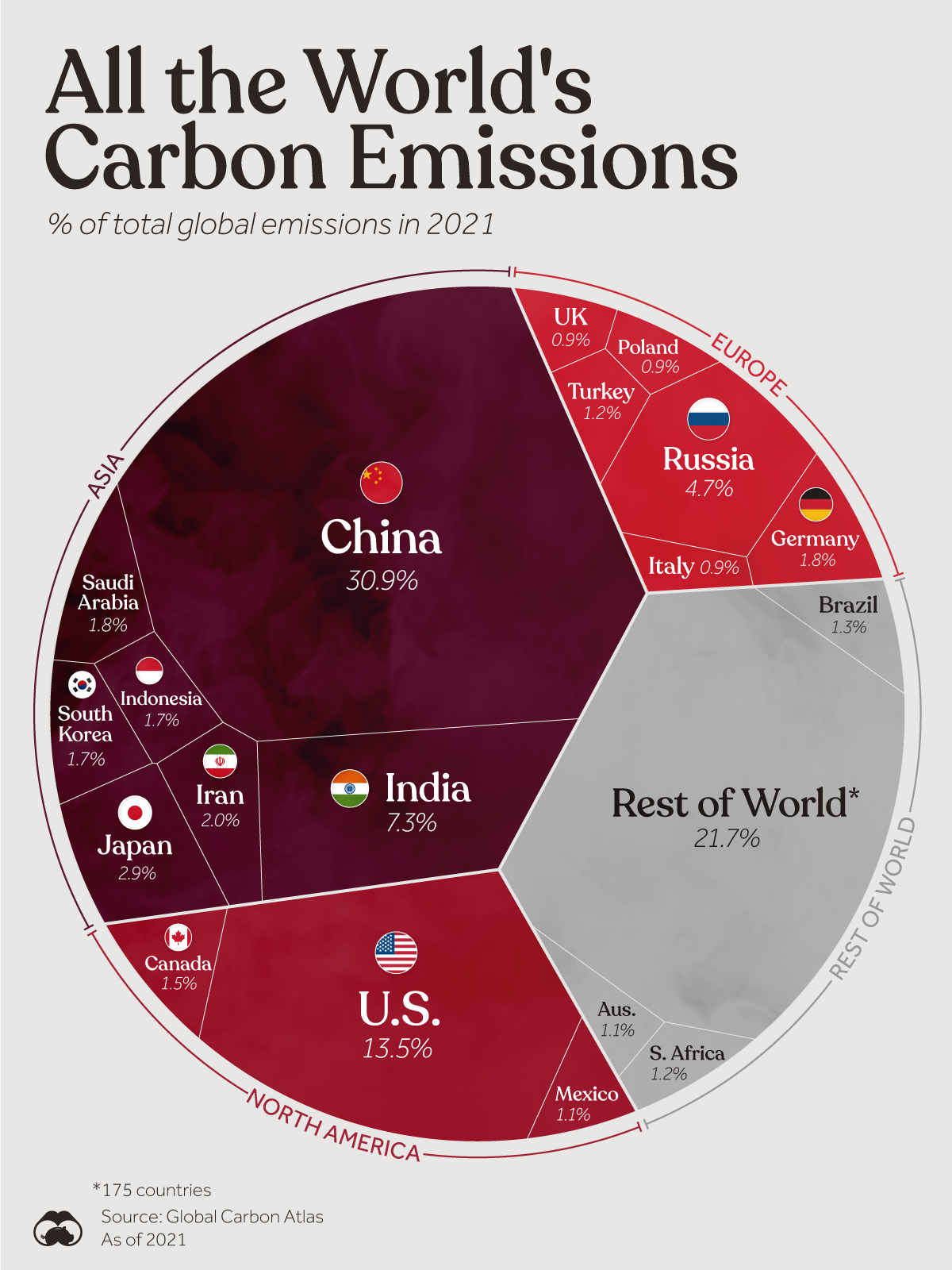Green
Visualizing All the World’s Carbon Emissions by Country

Visualizing All The World’s Carbon Emissions By Country
The greenhouse effect, essential for sustaining Earth’s life-friendly temperatures, has been intensified by burning fossil fuels.
This amplification of the natural greenhouse effect has led to significant alterations to the planet’s climate system.
The graphic above uses data from the Global Carbon Atlas to explore which countries contribute the most to CO₂ emissions.
Ranked: Global CO₂ Emissions by Country
According to the Global Carbon Atlas, the world’s top polluters are China, India, and the U.S., which accounted for 52% of the world’s CO₂ in 2021.
These countries are also the biggest in terms of population.
| Rank | Country | Region | Total Emissions (%) |
|---|---|---|---|
| #1 | 🇨🇳 China | Asia | 30.9% |
| #2 | 🇺🇸 U.S. | North America | 13.5% |
| #3 | 🇮🇳 India | Asia | 7.3% |
| #4 | 🇷🇺 Russia | Europe | 4.7% |
| #5 | 🇯🇵 Japan | Asia | 2.9% |
| #6 | 🇮🇷 Iran | Asia | 2.0% |
| #7 | 🇩🇪 Germany | Europe | 1.8% |
| #8 | 🇸🇦 Saudi Arabia | Other | 1.8% |
| #9 | 🇮🇩 Indonesia | Asia | 1.7% |
| #10 | 🇰🇷 South Korea | Asia | 1.7% |
| #11 | 🇨🇦 Canada | North America | 1.5% |
| #12 | 🇧🇷 Brazil | South America | 1.3% |
| #13 | 🇹🇷 Türkiye | Europe | 1.2% |
| #14 | 🇿🇦 South Africa | Africa | 1.2% |
| #15 | 🇲🇽 Mexico | North America | 1.1% |
| #16 | 🇦🇺 Australia | Oceania | 1.1% |
| #17 | 🇬🇧 UK | Europe | 0.9% |
| #18 | 🇮🇹 Italy | Europe | 0.9% |
| #19 | 🇵🇱 Poland | Europe | 0.9% |
| n/a | 🌐 Rest of World | Other | 21.7% |
In terms of CO₂ emissions per capita (metric tons), the U.S. is relatively high at 15.32, while China and India rank lower at 7.44 and 1.89, respectively.
Historically, the U.S. has been the largest carbon emitter, releasing 422 billion metric tons of CO₂ into the atmosphere since the Industrial Revolution. This is equivalent to almost a quarter of all CO₂ produced from fossil fuels and industrial activities.
Given their massive populations and the fact that countries typically increase their emissions as they become more developed, China and India may continue to grow their shares even further. The International Energy Agency (IEA) forecasts that India’s share of global emissions could rise to 10% by 2030.
All of these major contributors of carbon to the atmosphere have set goals to reduce emissions over the next decades. While the U.S. targets net-zero emissions by 2050, China aims for carbon neutrality by 2060 and India recently set a target of 2070.
Green
The Carbon Footprint of Major Travel Methods
Going on a cruise ship and flying domestically are the most carbon-intensive travel methods.

The Carbon Footprint of Major Travel Methods
This was originally posted on our Voronoi app. Download the app for free on iOS or Android and discover incredible data-driven charts from a variety of trusted sources.
Did you know that transport accounts for nearly one-quarter of global energy-related carbon dioxide (CO₂) emissions?
This graphic illustrates the carbon footprints of major travel methods measured in grams of carbon dioxide equivalent (CO₂e) emitted per person to travel one kilometer. This includes both CO₂ and other greenhouse gases.
Data is sourced from Our World in Data, the UK Government’s Department for Energy Security and Net Zero, and The International Council on Clean Transportation, as of December 2022.
These figures should be interpreted as approximations, rather than exact numbers. There are many variables at play that determine the actual carbon footprint in any individual case, including vehicle type or model, occupancy, energy mix, and even weather.
Cruise Ships are the Most Carbon-Intensive Travel Method
According to these estimates, taking a cruise ship, flying domestically, and driving alone are some of the most carbon-intensive travel methods.
Cruise ships typically use heavy fuel oil, which is high in carbon content. The average cruise ship weighs between 70,000 to 180,000 metric tons, meaning they require large engines to get moving.
These massive vessels must also generate power for onboard amenities such as lighting, air conditioning, and entertainment systems.
Short-haul flights are also considered carbon-intensive due to the significant amount of fuel consumed during initial takeoff and climbing altitude, relative to a lower amount of cruising.
| Transportation method | CO₂ equivalent emissions per passenger km |
|---|---|
| Cruise Ship | 250 |
| Short-haul flight (i.e. within a U.S. state or European country) | 246 |
| Diesel car | 171 |
| Gas car | 170 |
| Medium-haul flight (i.e. international travel within Europe, or between U.S. states) | 151 |
| Long-haul flight (over 3,700 km, about the distance from LA to NY) | 147 |
| Motorbike | 113 |
| Bus (average) | 96 |
| Plug-in hybrid | 68 |
| Electric car | 47 |
| National rail | 35 |
| Tram | 28 |
| London Underground | 27 |
| Ferry (foot passenger) | 19 |
| Eurostar (International rail) | 4.5 |
Are EVs Greener?
Many experts agree that EVs produce a lower carbon footprint over time versus traditional internal combustion engine (ICE) vehicles.
However, the batteries in electric vehicles charge on the power that comes straight off the electrical grid—which in many places may be powered by fossil fuels. For that reason, the carbon footprint of an EV will depend largely on the blend of electricity sources used for charging.
There are also questions about how energy-intensive it is to build EVs compared to a comparable ICE vehicle.
-

 Debt1 week ago
Debt1 week agoHow Debt-to-GDP Ratios Have Changed Since 2000
-

 Countries2 weeks ago
Countries2 weeks agoPopulation Projections: The World’s 6 Largest Countries in 2075
-

 Markets2 weeks ago
Markets2 weeks agoThe Top 10 States by Real GDP Growth in 2023
-

 Demographics2 weeks ago
Demographics2 weeks agoThe Smallest Gender Wage Gaps in OECD Countries
-

 United States2 weeks ago
United States2 weeks agoWhere U.S. Inflation Hit the Hardest in March 2024
-

 Green2 weeks ago
Green2 weeks agoTop Countries By Forest Growth Since 2001
-

 United States2 weeks ago
United States2 weeks agoRanked: The Largest U.S. Corporations by Number of Employees
-

 Maps2 weeks ago
Maps2 weeks agoThe Largest Earthquakes in the New York Area (1970-2024)














